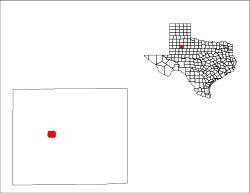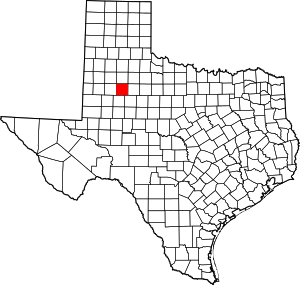Post, Texas
Post is a city in and the county seat of Garza County, Texas, United States.[5] The population was 5,376 at the 2010 census.
Post, Texas | |
|---|---|
Garza County Historical Museum in Post is a restored sanitarium. | |
Location of Post, Texas | |
 | |
| Coordinates: 33°11′30″N 101°22′50″W | |
| Country | United States of America |
| State | Texas |
| County | Garza |
| Area | |
| • Total | 3.77 sq mi (9.77 km2) |
| • Land | 3.75 sq mi (9.70 km2) |
| • Water | 0.03 sq mi (0.08 km2) |
| Elevation | 2,605 ft (794 m) |
| Population (2010) | |
| • Total | 5,376 |
| • Estimate (2019)[2] | 5,115 |
| • Density | 1,365.82/sq mi (527.38/km2) |
| Time zone | UTC-6 (Central (CST)) |
| • Summer (DST) | UTC-5 (CDT) |
| ZIP code | 79356 |
| Area code(s) | 806 |
| FIPS code | 48-59012[3] |
| GNIS feature ID | 1365627[4] |
| Website | www |
History
Post is located on the edge of the caprock escarpment of the Llano Estacado, the southeastern edge of the Great Plains. It is at the crossroads of U.S. Routes 84 and 380.
The land belonged to John Bunyan Slaughter, as it was on his U Lazy S Ranch.[6] In 1906, Slaughter sold it to Charles William (C. W.) Post, the breakfast cereal manufacturer, who founded "Post City" as a utopian colonizing venture in 1907. Post devised the community as a model town.[7][8] He purchased 200,000 acres (810 km2) of ranchland and established the Double U Company to manage the town's construction. The company built trim houses and numerous structures, which included the Algerita Hotel, a gin, and a textile plant. They planted trees along every street and prohibited alcoholic beverages and brothels. The Double U Company rented and sold farms and houses to settlers. A post office began in a tent during the year of Post City's founding, being established (with the name Post) July 18, 1907, with Frank L. Curtis as first postmaster.[9] Two years later, the town had a school, a bank, and a newspaper, the Post City Post, the same name as the daily in St. Louis, Missouri. The Garza County paper today is called the Post Dispatch. The railroad reached the town in 1910. The town changed its name to "Post" when it incorporated in 1914, the year of C. W. Post's death. By then, Post had a population of 1000, 10 retail businesses, a dentist, a physician, a sanitarium, and Baptist, Methodist, and Presbyterian churches.
From 1910 to 1913, Post experimented with attempts at rainmaking. Explosives were detonated in the atmosphere at timed intervals. Precipitation records, however, showed that the efforts failed.[10]
The C. W. Post estate pledged $75,000, and the town raised $35,000 in 1916 to bid unsuccessfully to become the site of the proposed West Texas Agricultural and Mechanical College.
Postex Cotton Mills began production in 1913 with 250 employees. When the Post interests sold the business in 1945 to Ely and Walker Dry Goods Company of St. Louis, the plant was producing six million yards of cloth a year and employed 375 workers who manufactured Postex cotton sheets and Garza pillow cases. Ely and Walker sold Postex in 1955 to Burlington Industries, the world's largest textile manufacturer at that time. By 1973, the company employed 450 persons. The mill has since closed.
Oilfield service companies have been important to the economy, as have farming and ranching. In 1989, Post had two libraries, a hospital, a nursing home, an airport, the Post Dispatch (founded 1926), and 90 businesses. The population reached 3,400 in 1928, declined to 2,000 in 1940, and increased to 3,100 during the 1950s. With the development of the local oil industry, the town's population attained its highest level of 4,800 in 1964. The 1980 census showed a population of 3,864, but by 1988, the Texas Almanac reported 4,162. In 1990, the population was 3,768.
The former sanitarium in Post is preserved as the Garza County Historical Museum. It is located to the right rear of the courthouse. Linda G. Puckett is the museum director.
Many ranchers and civic boosters live in Garza County, among them Giles McCrary, a former mayor who until his death in 2011 operated the OS Museum, a hybrid of exhibits from both the American West and Asia, which are changed three times per year. Two baseball fields in Post are named for former resident Norm Cash.
Geography
Post is located on the rolling plains at the foot of the Llano Estacado at 33°11′30″N 101°22′50″W (33.191789, -101.380432).[11]
According to the United States Census Bureau, the city has a total area of 3.8 square miles (9.8 km2), of which 3.8 square miles (9.8 km2) are land and 0.04 square miles (0.10 km2) of it (0.53%) is covered by water.
Climate
According to the Köppen climate classification system, Post has a semiarid climate, BSk.[12] According to other climatic maps, it falls in a subtropical climate (Köppen: Cfa). Surpassing the 100° meridian, it is the city more to the west in the USA with such categorization. In any case, the city suffers influence from both sides, being the transition from a humid to dry environment in the subtropics.[13]
Major roads and highways





Demographics
| Historical population | |||
|---|---|---|---|
| Census | Pop. | %± | |
| 1920 | 1,436 | — | |
| 1930 | 1,668 | 16.2% | |
| 1940 | 2,046 | 22.7% | |
| 1950 | 3,141 | 53.5% | |
| 1960 | 4,663 | 48.5% | |
| 1970 | 3,854 | −17.3% | |
| 1980 | 3,961 | 2.8% | |
| 1990 | 3,768 | −4.9% | |
| 2000 | 3,708 | −1.6% | |
| 2010 | 5,376 | 45.0% | |
| Est. 2019 | 5,115 | [2] | −4.9% |
| U.S. Decennial Census[14] | |||
As of the census[3] of 2000, 3,708 people, 1,243 households, and 873 families resided in the city. The population density was 988.8 people per square mile (381.8/km2). The 1,419 housing units averaged 378.4 per square mile (146.1/km2). The racial makeup of the city was 51.54% white, 5.47% African American, 0.24% Native American, 0.11% Asian, 18.69% from other races, and 2.91% from two or more races. About 42.64% of the population was Hispanic or Latino.
Of the 1,243 households, 34.8% had children under the age of 18 living with them, 53.5% were married couples living together, 13.0% had a female householder with no husband present, and 29.7% were not families. About 26.6% of all households were made up of individuals, and 13.9% had someone living alone who was 65 years of age or older. The average household size was 2.62 and the average family size was 3.17.
In the city, the population was distributed as 27.5% under the age of 18, 8.8% from 18 to 24, 29.4% from 25 to 44, 20.0% from 45 to 64, and 14.4% who were 65 years of age or older. The median age was 34 years. For every 100 females, there were 114.5 males. For every 100 females age 18 and over, there were 115.8 males.
The median income for a household in the city was $25,034, and for a family was $29,135. Males had a median income of $26,318 versus $17,266 for females. The per capita income for the city was $11,113. About 23.0% of families and 27.8% of the population were below the poverty line, including 34.2% of those under age 18 and 25.9% of those age 65 or over.
Post is served by two weekly newspapers, nearby stations KBXJ (FM) and KPET (AM), and the various Lubbock radio and TV stations. KPOS(AM) was licensed to Post, but was deleted (license turned into FCC) for cancellation in 1998 when the sister FM was upgraded to cover Slaton and the Lubbock area. KSSL(FM)is licensed to Post, but operates primarily from offices and studios in Slaton.
Education
The City of Post is served by the Post Independent School District and home to the Post High School Antelopes.
Arts and culture
Post observed its centennial in 2007. Festivities began with a parade and were followed by the All-School Reunion Dance, which featured the band Thrift Store Cowboys from Post, Texas. Old Mill Trade Days offered six hours of live music, as well as other activities. Throughout the weekend commemoration, art shows, museum exhibits, and theater productions were held to observe the centennial.
In 1987, the Texas Historical Commission designated Post as a Texas Main Street City. Main Street is lined with gift and clothing stores located in restored historic buildings. Centennial Plaza on the courthouse lawn honors veterans and Post civic leaders.[10]
The Garza Theatre (1920-1957) on Main Street was among the first theaters in West Texas dating back to the age of the silent screen. In 1986, the Garza was renovated and reopened for community events.[10] Regular films are offered at the Tower Theater.
The town is the site of a pivotal scene in the 2016 movie Hell or High Water.
Gallery
- City welcome sign
- Downtown historic district
- Hotel Garza Bed and Breakfast
- Garza Theatre hosts community events
- C.W. Post statue in front of the Garza County Courthouse
- City Hall
- Post Public Library
- Tower Theater is adjacent to the library
- Algerita Arts Center is housed in a former hotel in the Post Historic District.
- J. Cruse Christmas Gallery downtown; behind the gallery is the OS Museum, developed by Giles McCrary.
- Post Stampede Rodeo stadium
- First United Methodist Church at 216 West Tenth Street
- First Baptist Church at 402 West Main Street observed its centennial in 2008.
- Holly's Drive-In on U.S. Highway 84 in south Post
 Picker at Postex Cotton Mills, Post, Texas (postcard, circa 1913-1918)
Picker at Postex Cotton Mills, Post, Texas (postcard, circa 1913-1918)
See also
- Close City, Texas, the original site of Post City, Texas
- Double Mountain Fork Brazos River
- Justiceburg, Texas
- Llano Estacado
- West Texas
| Wikimedia Commons has media related to Post, Texas. |
References
- "2019 U.S. Gazetteer Files". United States Census Bureau. Retrieved August 7, 2020.
- "Population and Housing Unit Estimates". United States Census Bureau. May 24, 2020. Retrieved May 27, 2020.
- "U.S. Census website". United States Census Bureau. Retrieved 2008-01-31.
- "US Board on Geographic Names". United States Geological Survey. 2007-10-25. Retrieved 2008-01-31.
- "Find a County". National Association of Counties. Retrieved 2011-06-07.
- Anderson, H. Allen (June 15, 2010). "SLAUGHTER, JOHN BUNYAN". Handbook of Texas Online. Texas State Historical Association. Retrieved December 31, 2015.
- Post, Texas profile, Texas State Historical Association
- "From Post to present: Failed utopia offers lessons for modern planners, experts say". Fort Worth Star-Telegram. June 25, 2001. p. 1.
- Schmidt, Walter G. (1993) An Encyclopaedia of Texas Post Offices, p. 173, Chicago, Illinois: The Collectors' Club of Chicago.
- Texas State Travel Guide 2011, p. 131
- "US Gazetteer files: 2010, 2000, and 1990". United States Census Bureau. 2011-02-12. Retrieved 2011-04-23.
- Climate Summary for Post, Texas
- "Interactive United States Koppen-Geiger Climate Classification Map". www.plantmaps.com. Retrieved 2018-10-11.
- "Census of Population and Housing". Census.gov. Retrieved June 4, 2015.

